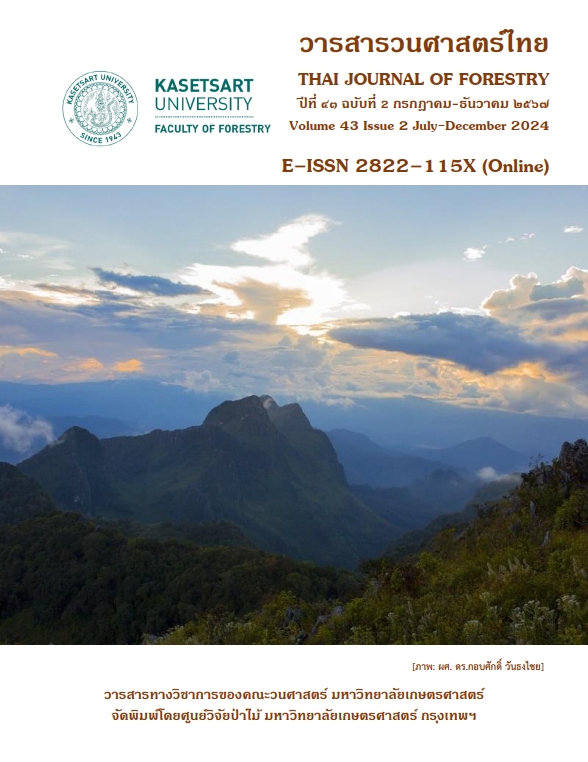การเปรียบเทียบวิธีการจำแนกการใช้ประโยชน์ที่ดิน จากข้อมูลภาพดาวเทียม Landsat 9 บริเวณเขตพัฒนาพิเศษภาคตะวันออก ประเทศไทย
Main Article Content
บทคัดย่อ
การศึกษาครั้งนี้มีวัตถุประสงค์เพื่อศึกษาเปรียบเทียบผลลัพธ์ของการจำแนกการใช้ประโยชน์ที่ดินจากข้อมูลภาพดาวเทียม Landsat 9 ระบบบันทึกข้อมูล OLI-2 ความละเอียดจุดภาพ 30 เมตร ด้วยวิธีการแปลตีความข้อมูลภาพดาวเทียมด้วยสายตา การจำแนกประเภทข้อมูลแบบกำกับดูแลด้วยวิธี maximum likelihood และเทคนิคการเรียนรู้ของเครื่องแบบ Random forest บริเวณเขตพัฒนาพิเศษภาคตะวันออก ภายใต้การแบ่งกลุ่มการใช้ประโยชน์ที่ดินออกเป็น 5 ประเภท ได้แก่ พื้นที่ป่าไม้ พื้นที่แหล่งน้ำ พื้นที่เกษตรกรรม พื้นที่ชุมชนและสิ่งปลูกสร้าง และพื้นที่เบ็ดเตล็ด โดยใช้เทคนิคการซ้อนทับข้อมูลในระบบสารสนเทศภูมิศาสตร์ ในการสรุปผลความแตกต่างของการจำแนกการใช้ประโยชน์ที่ดินในแต่ละวิธี
ผลการศึกษาพบว่า ภายในเขตพัฒนาพิเศษภาคตะวันออก มีพื้นที่ 13,343.03 ตารางกิโลเมตร เมื่อใช้วิธีการแปลตีความข้อมูลภาพดาวเทียมด้วยสายตาจากข้อมูลภาพดาวเทียม Landsat 9 พบว่า มีค่าความถูกต้องโดยรวมร้อยละ 97.30 รองลงมาได้แก่ เทคนิคการเรียนรู้ของเครื่องแบบ Random forest และแบบกำกับดูแลด้วยวิธี maximum likelihood โดยมีค่าความถูกต้องโดยรวมร้อยละ 67.57 และ 64.86 ตามลำดับ เมื่อเปรียบเทียบผลลัพธ์ของการแปลตีความการใช้ประโยชน์ที่ดินจากข้อมูลภาพดาวเทียม Landsat 9 ด้วยสายตา ซึ่งเป็นข้อมูลที่มีความถูกต้องโดยรวมสูงที่สุด กับผลลัพธ์ที่ได้จากการจำแนกการใช้ประโยชน์ที่ดินอีกสองวิธี โดยใช้เทคนิคการซ้อนทับข้อมูลในระบบสารสนเทศภูมิศาสตร์ พบว่า เทคนิคการเรียนรู้ของเครื่องแบบ Random forest มีผลลัพธ์ความถูกต้องในการจำแนกประเภทข้อมูลทั้ง 5 ประเภทการใช้ประโยชน์ที่ดิน เท่ากับ 8,441.25 ตารางกิโลเมตร หรือคิดเป็นร้อยละ 63.26 ของพื้นที่เขตพัฒนาพิเศษภาคตะวันออก ซึ่งมีผลลัพธ์ความถูกต้องสูงกว่าแบบกำกับดูแลด้วยวิธี maximum likelihood
Downloads
Article Details

อนุญาตภายใต้เงื่อนไข Creative Commons Attribution-NonCommercial-NoDerivatives 4.0 International License.
ข้าพเจ้าและผู้เขียนร่วม (ถ้ามี) ขอรับรองว่า ต้นฉบับที่เสนอมานี้ยังไม่เคยได้รับการตีพิมพ์และไม่ได้อยู่ในระหว่างกระบวนการพิจารณาตีพิมพ์ลงในวารสารหรือสิ่งตีพิมพ์อื่นใด ข้าพเจ้าและผู้เขียนร่วม (ถ้ามี) ยอมรับหลักเกณฑ์และเงื่อนไขการพิจารณาต้นฉบับ ทั้งยินยอมให้กองบรรณาธิการมีสิทธิ์พิจารณาและตรวจแก้ต้นฉบับได้ตามที่เห็นสมควร พร้อมนี้ขอมอบลิขสิทธิ์ผลงานที่ได้รับการตีพิมพ์ให้แก่วารสารวนศาสตร์ คณะวนศาสตร์ มหาวิทยาลัยเกษตรศาสตร์ กรณีมีการฟ้องร้องเรื่องการละเมิดลิขสิทธิ์เกี่ยวกับภาพ กราฟ ข้อความส่วนใดส่วนหนึ่ง หรือ ข้อคิดเห็นที่ปรากฏในผลงาน ให้เป็นความรับผิดชอบของข้าพเจ้าและผู้เขียนร่วม (ถ้ามี) แต่เพียงฝ่ายเดียว และหากข้าพเจ้าและผู้เขียนร่วม (ถ้ามี) ประสงค์ถอนบทความในระหว่างกระบวนการพิจารณาของทางวารสาร ข้าพเจ้าและผู้เขียนร่วม (ถ้ามี) ยินดีรับผิดชอบค่าใช้จ่ายทั้งหมดที่เกิดขึ้นในกระบวนการพิจารณาบทความนั้น”
เอกสารอ้างอิง
Altman, D.G. 1991. Practical Statistics for Medical Research. Chapman and Hall, London, UK.
Ali, U., Esau, T.J., Farooque, A.A., Zaman, Q.U., Abbas, F., Bilodeau, M.F. 2022. Limiting the collection of ground truth data for land use and land cover maps with machine learning algorithms. ISPRS International Journal of Geo–Information, 11(6): 333. doi:10.3390/ijgi11060333
Anderson, J.R. 1971. Land use classification schemes used in selected recent geographic applications of remote sensing. Photogrammetric Engineering, 37(4): 379-387.
Congalton, R., Green, K. 2019. Assessing the Accuracy of Remotely Sensed Data: Principles and Practices 3rd ed. New York, USA.
Dias, H.C., Sandre, L.H., Alarcón, D.A.S., Grohmann, C.H., Quintanilha, J.A. 2021. Landslide recognition using SVM, random forest, and maximum likelihood classifiers on high-resolution satellite images: A case study of Itaóca, Southeastern Brazil. Brazilian Journal of Geology, 51(4): e20200105.
Geo-Informatics and Space Technology Development Agency (GISTDA). 2009. Space Technology and Geo-informatics. Amarin Corporations Public Company Limited, Bangkok, Thailand. (in Thai)
Ihlen, V. 2019. Landsat 8 (L8) Data Users Handbook. U.S. Geological Survey: Sioux Falls, South Dakota, USA.
JavaTpoint. 2022. Random Forest Algorithm. https://www.javatpoint.com/machine–learning–random–forest–algorithm, 10 June 2022.
Jensen, J.R. 1986. Introductory Digital. Image Processing, Prentice–Hall, New Jersey, USA.
Karasiak, N. 2021. Dzetsaka Qgis Classification Plugin. https://github.com/nkarasiak/dzetsaka, 19 July 2021.
Karasiak, N., Perbet, P. 2018. Remote sensing of distinctive vegetation in Guiana Amazonian Park. QGIS and Applications in Agriculture and Forest, 2: 215-245. doi:10.1002/9781119457107.ch7
Khunrattanasiri, W. 2020. Satellite Imagery for Forest Resource Survey. Department of Forest Management, Faculty of Forestry, Kasetsart University, Bangkok, Thailand. (in Thai)
Lakshmi, N.K., Priti, N. 2015. Multi–temporal land use classification using hybrid approach. The Egyptian Journal of Remote Sensing and Space Science, 18(2), 289-295. doi:10.1016/j.ejrs.2015.09.003
Land Development Department. 2012. Land Use Classification. Office of Soil Survey and Land Use Planning, Land Development Department, Bangkok, Thailand. (in Thai)
Land Development Department. 2020. Land Use Conditions Report for the Year 2020. Land Development Department, Ministry of Agriculture and Cooperatives, Bangkok, Thailand. (in Thai)
Land Development Department. 2021. Land Use Conditions Report for the Year 2021. Land Development Department, Ministry of Agriculture and Cooperatives, Bangkok, Thailand. (in Thai)
Lillesand, T.M., Kiefer, R.W., Chipman, J.W. 2015. Remote Sensing and Image Interpretation, 7st ed. John Wiley and Sons, Inc., USA.
Landis, R.J., Koch, G.G. 1977. The measurement of observer agreement for categorical data. Biometrics, 33(1), 159-174. doi:https://doi.org/10.2307/2529310
Loukika, K.N., Keesara, V.R., Sridhar, V. 2021. Analysis of land use and land cover using machine learning algorithms on Google Earth engine for Munneru River Basin, India. Sustainability, 13(24): 13758. doi:10.3390/su132413758
Office of the Prime Minister. 2019. National strategy 2018–2037. Government Gazette. vol.136, Part 51. (dated April 18, 2019). Bangkok, Thailand. (in Thai)
Ongsomwang, S. 2016. Remote Sensing System and Digital Image Analysis. Suranaree University of Technology, Nakhon Ratchasima, Thailand. (in Thai)
Potić, I., Potić, M. 2017. Remote sensing machine learning algorithms in environmental stress detection: Case study of Pan–European south section of corridor 10 in Serbia. University thought–Publication in Natural Sciences, 7(2): 41-46. doi:10.5937/univtho7-14957
Richards, J.A., Jia, X. 2006. Remote Sensing Digital Image Analysis: An Introduction. Germany: Springer, Berlin, Germany.
Rimal, B., Rijal, S., Kunwar, R. 2020. Comparing support vector machines and maximum likelihood classifiers for mapping of urbanization. Journal of the Indian Society of Remote Sensing, 48(1), 71-79. doi:10.1007/s12524-019-01056-9
Sanguansat, P. 2019. Artificial Intelligence with Machine Learning AI. IDC Premier Co., Ltd, Nonthaburi, Thailand. (in Thai)
Saraubon, K. 2020. Learn Data Science AI: Machine Learning with Python. Horsom Media Network, Bangkok, Thailand. (in Thai)
Sayler, K. 2022. Landsat 9 Data Users Handbook. U.S. Geological Survey: Sioux Falls, South Dakota, USA.
Secretariat of the House of Representatives. 2017. Eastern Economic Corridor (EEC): New Hope for Thailand's Sustainable Economic Growth. https://www.parliament.go.th/ewtadmin/ewt/parliament_parcy/ewt_dl_link.php?nid=45250, 10 June 2022. (in Thai)
Story, M., Congalton, R. 1986. Accuracy assessment: A user’s perspective. Photogrammetric Engineering and Remote Sensing, 52(3): 397-399.
Talukdar, S., Singha, P., Mahato, S., Shahfahad; Pal, S., Liou, Y.A. 2022. Rahman, a land–use land–cover classification by machine learning classifiers for satellite observations-a review. Remote Sensing, 12: 1135. doi:10.3390/rs12071135
Thai Government. 2018. Eastern special development zone act B.E. 2561 (2018). Government Gazette. vol.135, Part 34. (dated May 14, 2018). Bangkok, Thailand. (in Thai)
Tontisirin, N., Anantsuksomsri, S. 2021. Economic development policies and land use changes in Thailand: From the Eastern Seaboard to the Eastern Economic Corridor. Sustainability, 13(11), 6153. doi:10.3390/su13116153
Wettasin, M., Chaiyarat, R., Youngpoy, N., Jieychien, N., Sukmasuang, R., Tanhan, P. 2023. Environmental factors induced crop raiding by wild Asian elephant (Elephas maximus) in the Eastern Economic Corridor, Thailand. Scientific Reports, 13(1): 13388. doi:10.1038/s41598-023-40070-3


